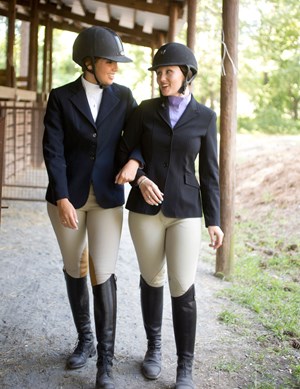
Your reflection in the mirror says it all: Your show clothes have seen better days. They look a bit worn and don’t fit as well as they used to. They’re in serious need of updating before you and your horse next compete.
The surest remedy for the situation?
Head to a tack shop that you trust and put yourself in the hands of a savvy staffer who’ll help you navigate the sea of choices in equestrian apparel. The emergence of technical fabrics—those state-of-the-art materials that wick moisture, repel odors, resist pilling, protect against the sun’s harmful rays and more—has transformed traditional riding wear and broadened the offerings in all categories. So, too, has the influence of European-inspired designs. Closer-to-the-body cuts and fashion-forward styling now give classic breeches, shirts and show jackets a decidedly 21st century flair. It’s a welcome trend for riders who are physically fit and well-toned, but it can be intimidating for anyone whose figure falls short of perfection. To satisfy those riders’ needs, makers are incorporating figure-enhancing features—slimming seaming details, physique-shaping panels, concealed zippers for smoother lines—into many garments and adding accents such as contrasting piping and colorful linings to allow for a bit of self-expression. The upside: more options in equestrian apparel from which to choose. The downside: having all those choices overwhelm you as you shop for show wear that not only is appropriate for your discipline but that also makes you look great and feel good.
Sizing Up the Situation
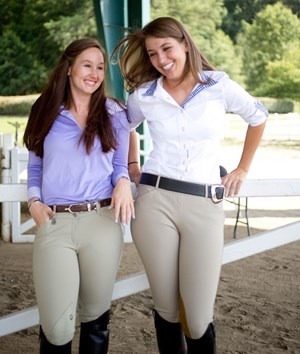
“Most people usually need a lot of help selecting well-fitting riding apparel,” says Beth Lee, who for 30 years has owned Atlanta Saddlery, a full-service tack shop for English riders in Alpharetta, Georgia. The marketplace’s rapid embrace of high-tech fabrics is a significant factor, she says: “I’ve probably seen more changes in riding clothes in the last year than in the last 20.” She estimates that about “95 percent of the clothing we now carry is made of technical fabric. A year ago, it was probably closer to 60 percent.” Plus, Beth notes, riders are taking cues from elite competitors when setting their sights on what they want to wear in the show ring. “Here in the southeast, riders are influenced by what they see during the winter competitive season in Wellington and Ocala, Florida.” She adds that trends that once took at least a year to emerge in her area now surface within a matter of months.
As a result, Beth adapts Atlanta Saddlery’s inventory to keep pace with the needs and desires of its clientele: a mix of dressage and hunter/jumper riders, show jumpers, eventers, foxhunters and pleasure riders, diverse in age and proficiency as well as shape and size. A half-dozen store employees “are great at staying up on what’s current,” Beth says, and a rider can benefit from their expertise even before she begins combing a rack for her size.
What the Pros Know
Unlike the fashion industry, which has established guidelines, “there’s no standardized sizing for equestrian apparel,” Beth says. Garment sizes vary from maker to maker and from generally accepted fashion-industry standards. For example, a woman who normally wears a size 10 blazer may need a size 12 or larger show coat, depending on the cut and manufacturer. That’s why Beth recommends enlisting the aid of a knowledgeable sales associate and being ready to try on a variety of sizes and styles when shopping for show apparel. Come prepared, she advises, to ensure proper fit. Pack along some patience and, even more important, wear the sort of undergarments—say, a sports bra and Spanx or other foundation—that you normally would while riding. Bring your boots, too, if it’s practical, to check the length and look of any breeches you may consider.
Typically, a well-versed clerk will ask about the sizes you usually wear as well as your preferences for fit and any body issues you’d like to address, whether it’s flaunting an asset or minimizing a flaw. She’ll need to know your sport to make certain the garments you choose are acceptable for competition (a check of the 2014 U.S. Equestrian Federation Rule Book will eliminate any doubt). And don’t be surprised if she asks about your trainer or coach. He or she may be partial to a certain manner of dress—a not-inconsequential consideration when a rider wants to ensure that her attire doesn’t distract from her performance.
A Word About Fabric
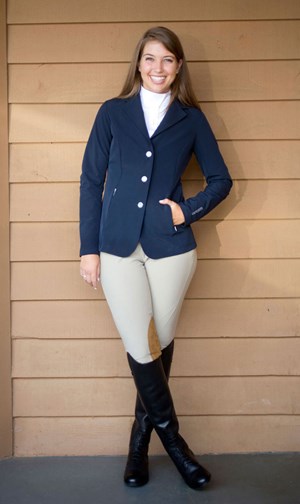
Though the cut of a garment largely determines its fit, the cloth it is made of plays a significant role in how it looks, performs and wears. Whether made of natural fiber (think: cotton and wool) or a state-of-the-art synthetic, fabric that is thin or very soft and silky to the touch may be sheer enough to see through when worn. In addition, certain technical fabrics are prone to static, and that means cling, which can be an unwelcome development when you’re trying to concentrate on your horse and performance during competition. A subtle pattern or texture woven into fabric can increase its substance. You’ll discover the pros and cons of the variety of materials available as you try on different garments and zero in on the weights and performance characteristics that work best for you.
Begin with Breeches
For fashion-conscious riders and even those who describe themselves as fashion-challenged, when it comes to shopping for breeches, the focus is all about rise. “Nobody wants regular-rise breeches anymore,” Beth says. Breeches that come to the waist—once the standard—are in less demand as riders seek a more modern look, one that mimics the fit of their favorite jeans.
By definition, “rise” is the distance between the center point of the crotch and the waist. But the adjective that usually precedes it—“low,” “mid” or “modified,” for example—can sway a rider’s thinking. The key to choosing a well-fitting, figure-flattering breech, Beth advises, is not to let terminology guide you. Instead, focus on choosing a style that comes at least to your hipbones when you put it on. You’ll know that a breech is right for you when it
• feels snug, but doesn’t pinch or bind
• lies smoothly against your body, from waist to calf, as you stand
• wrinkles minimally at the thigh top and knee when you move
• resists gapping at the waist when you sit and move as you would in the saddle
• has knee patches that align with your knees
• is sufficiently long to tuck into the top of your tall boots. According to your preference, that’s a point somewhere below the calf and to the ankle bone.
What’s trending: Technical fabrics that contain some percentage of cotton combined with a fiber that provides stretch (for instance, spandex, elastane, Lycra or elastomer); Euro-seat stitching that runs up the back of the leg and curves around the seat (a very hot trend, according to Beth).
Features for the figure-conscious: Compression fibers integrated into the fabric for overall support; 4-way stretch so the fabric gives both crosswise and lengthwise for freedom of movement (2-way stretch material gives in just one direction); a rise that is shorter in front and higher in back for a modern look that doesn’t compromise coverage front or rear; a concealed zipper, front or side; angled (“slash”) front pockets to visually slim the silhouette; a lining between the front pockets for abdominal support; a wide, flexible, yet structured, waistband (perhaps with an elastic insert at the back for added stretch) to increase comfort and mobility as well as to avoid accentuating or creating a muffin-top bulge of flesh.
Add a Shirt
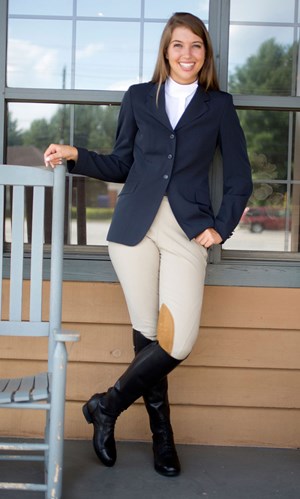
Competition shirts made of traditional cotton and cotton blends have been joined by a variety of garments fashioned from technical fabric. In many cases, their design reflects makers’ desire to increase the show shirt’s versatility and appeal. A number are now styled for wear in the show ring and beyond, meaning they are as suited to competition, under a coat or alone, as they are to an outing in town. Some have the casual look of a polo shirt. Others are dressier. Some, when open at the collar and cuff, reveal a colored or patterned lining. There also are shirts that offer features popular in athletic wear: mesh underarm inserts to facilitate air circulation or fabric that’s able to convert sweat to a coolant to lower body temperature. Show shirts that are easy-care can be machine-washed and line- or machine-dried—a definite advantage for a rider too busy or simply not inclined to want to heat up an iron.
Fit considerations for a show shirt include:
• sufficient length so it can be tucked into breeches, whatever their rise, and stay put as you move. Often this can be accomplished with a shirt that has a drop-back hem, which is longer in back than in front.
• enough well-placed buttons or snaps for a smooth fit at the front—no pulling or gapping—especially across the bust.
• cuffs that do not pass over your hand once they’re buttoned or snapped or extend more than a half-inch beyond the sleeve of your show coat when your arms are at your sides.
In addition, check that the fabric of the shirt works with the fabric of your show coat. Cotton or synthetic under wool may be fine. The same is true for synthetic under synthetic. But cotton under synthetic may not move as fluidly as desirable and could end up restricting or interfering with movement.
What’s trending: Wrap collars with hidden snap or magnetic closures; odor-resistant and UV-protective technical fabrics for long, hot days of competition in the sun; contrast stitching details and subtle pleating; flat seaming—the joining of fabric edges with no overlap to minimize bulk.
Features for the figure-conscious: Darts to give a shirt shape and help it lie close to the body and smoothly under a coat; stretch side panels to do the same and facilitate movement; hidden zippers and covered plackets to prevent gapping of fabric at the bust; princess seams—long, rounded seams from the arms to the waist that add shape where it otherwise might be lacking.
Top it Off with a Coat
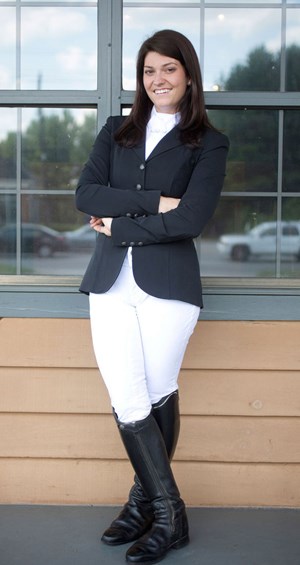

Perhaps no item of equestrian apparel has undergone as much change in the past several years as the rider’s show coat. In terms of fabric, classic wool is still highly regarded for its elegant look and timeless appeal. But coats made from high-tech materials have steadily gained ground, primarily because riders find them attractive and comfortable to wear, no matter what the weather. Among the most popular are those fashioned from various types of softshell—a woven technical fabric that stretches, breathes, retains its shape, wicks moisture, resists wind and water and often is machine-washable. European styling has significantly influenced the design of show coats, too, so that a number of offerings are shorter and more form-fitting than their traditionally cut counterparts. Trying on several styles, in a variety of fabric types and weights, will help you to determine the coat that best suits you. For a tailored appearance evaluate these factors:
• overall length—Beth’s rule of thumb for hunters and jumpers is for the coat to cover about half of the wearer’s derriere yet not be so long that a rider risks sitting on it after jumping; from the front, the ideal length is approximately where the legs meet the torso. Dressage coats traditionally extend over the buttocks and cover the hip joint when the rider is seated in the saddle. But a European-style coat won’t be as long. Either cut can provide an elegant line, both front and rear. Consider your body type as you make your choice. For example, the longer length of a traditional coat may be more flattering for a triangular or hourglass figure while a European design enhances a rectangular body build with few curves.
• shoulder fit—The top edge of the jacket sleeve comes just to the edge of the shoulder. The fabric lies flat across the back. It does not pull. There are no horizontal creases. You feel no restriction when you move as you would in the saddle. As a test, Beth recommends extending your arms as if you are hugging a tree.
• waist—The waist, especially if there is a seam, falls at your waist (the point at which you “break over” when you bend your torso to one side). There is a smooth taper to the fabric from bust to waist and beyond. There is no puckering or bagging. You have freedom to move.
• sleeve length—Ideally, the sleeve reaches to just below the bump of the wrist. However, length can vary a bit, Beth says, depending on whether a rider prefers to show a traditional half-inch of shirt cuff or none at all—the case when wearing a short-sleeved show shirt.
• drape—Study the general shape of the garment and the way the fabric hangs. It shouldn’t look limp, sag or bag or lie poorly over a lining or your frame. Even a lighter-weight fabric should appear to have substance for a crisp, elegant look.
What’s trending: The performance or competition coat, a hybrid of sorts that is suitable for either hunter/jumper or dressage competition. Generally made of easy-wear, easy-care technical fabric, this relative newcomer to the field may have three buttons (traditional for hunter/jumpers) or four (traditional for dressage) as well as double vents—details that can contribute to fit as well as freedom of movement. Also in vogue: black and navy for colors; stretch linings, some made of mesh, for comfort and unrestricted movement; contrast stitching and other details on pockets and lapels; buttons in silver or gold. On the horizon: patterned technical fabrics that may one day put subtle plaids and stripes in the show ring.
Features for the figure-conscious: zippers hidden under front buttons to prevent gapping; angled pockets; princess seams.
In all articles of riding apparel, some alterations are possible, whether done in-store, by a local tailor or by you if you’re handy with a needle and thread. But they should be minor—say, shortening sleeves—since an off-the-rack garment generally won’t have sufficient fabric for more major work. If an item’s fit is that off when you try it on, it’s better to shop for another version—for example, a “long” instead of a “regular” in a coat or breeches—another size or cut or a similar item from another manufacturer. You’ll know you’ve achieved success in selecting appropriate and figure-flattering riding apparel when your reflection in the mirror brings to mind descriptions like “elegant” and “well turned out.” Adds Beth, based on her years of experience, “You’ll also look and feel happy.”
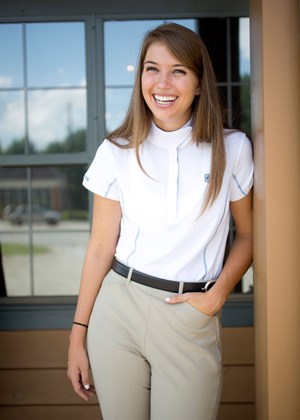
This article originally appeared in the October 2014 issue of Practical Horseman.
Save











